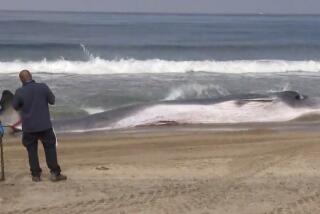SeaWorld’s new virtual reality show gets up close with killer whales

Orca 360 is part of the new Ocean Explorer area, which also made its debut in May and features aquariums and a mini submarine ride.
Watching killer whales cavort, leap and swim has long been the hallmark of a visit to SeaWorld, but now the San Diego park is taking visitors right into the water with the huge cetaceans — virtually.
DeepSee VR: Orca 360, which opened this month only at the San Diego park, is SeaWorld’s latest foray into virtual reality. The attraction relies on live-action, stereoscopic video that, SeaWorld boasts, has never been seen before and was created just for the virtual reality journey.
There is a $10 charge for the VR experience, on top of admission to the park. Advance reservations are required.
Up to 10 people at a time can be accommodated in a small room called the Simlab, designed as a futuristic laboratory with large, eggshell-shaped chairs that swivel and recline. A SeaWorld employee, dressed in a white lab coat, distributes special virtual reality goggles and a headset. Soon after, the audience is immersed in a 7½-minute visit with half a dozen orcas, as well as trainers who act as guides to the whales’ world above and below water.
One whale will snatch a fish right in front of you, another appears to be swimming toward you, while still another leaps out of the water, seemingly splashing you with water.
The video that people will see upon donning VR goggles was all filmed at SeaWorld Orlando in Florida, where SeaWorld Entertainment Inc.’s creative group is based.
Video production was also occurring while the San Diego park was in the midst of constructing a backdrop at its former Shamu stadium to accommodate the new Orca Encounter, the killer whale presentation that replaced the long-running Shamu show, SeaWorld San Diego spokesman David Koontz said.
“The quality of content you’ll see in that headset you can’t get at home,” said Brian Morrow, vice president of theme park design for SeaWorld Entertainment. “These are our whales and our trainers, and before this technology, it was a world only our trainers would see.”
Daily presentations will be offered twice an hour, and the number of them per day will depend on the operating hours of the park that day. On days when the park is open the longest, there will be about 20 Orca 360 presentations at most.
The attraction arrives two months after the launch of Orca Encounter, a documentary-style presentation that banished the theatrical flourishes of the Shamu shows in favor of live demonstrations of killer whale behaviors synced to wide-screen video of whales in the wild.
Orca 360 has a similar educational bent, demonstrating, for example, how a behaviorist takes a blowhole sample for veterinary exams, or how trainers retreat to the “fish house” to fill metal buckets with food for the orcas.
SeaWorld orca trainer Lindy Donahue likened the virtual reality experience to the behind-the-scenes tours the park has with other animals.
Orca 360 is part of the new Ocean Explorer area, which debuted in May and features aquariums and a mini-submarine ride.
It is an example of SeaWorld’s efforts to build visitation and broaden its reach with cutting-edge technology and attractions that will appeal to multiple age groups. The company has been trying to reverse a slowdown in attendance growth over the last few years after the 2013 release of the critical documentary “Blackfish.” More recently, visitation at the San Diego park has started to improve.
In preparing for the VR attraction, SeaWorld Entertainment initially invested in an outside start-up to help create a camera system capable of capturing underwater video in a 360-degree environment, Morrow said.
In all, four generations of 3-D 360 cameras were involved in the production, in addition to nearly 80 8K cameras that were used to capture a single shot. SeaWorld’s creative technology division, Expedition X, worked with animal care specialists, behaviorists and veterinarians for more than a year to design and build cameras that were considered safe for the whales and the saltwater environment.
Orca 360 is something of a proving ground for SeaWorld, which could conceivably adapt it to other marine mammal experiences.
“If we find our guests love this idea, you’ll see more of this and with different animals,” Morrow said earlier this year.
lori.weisberg@sduniontribune.com
More to Read
Inside the business of entertainment
The Wide Shot brings you news, analysis and insights on everything from streaming wars to production — and what it all means for the future.
You may occasionally receive promotional content from the Los Angeles Times.











